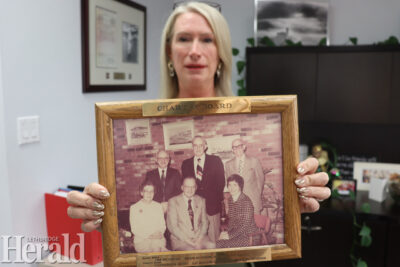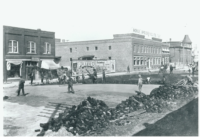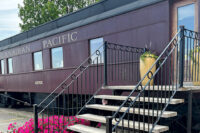LHA reaches 50-year milestone helping those who need homes
By Lethbridge Herald on August 26, 2024.
 Robin James, CAO of Lethbridge Housing Authority, holds up a photo of the organization's first board of directors in 1974.
Herald photo by Al Beeber
Robin James, CAO of Lethbridge Housing Authority, holds up a photo of the organization's first board of directors in 1974.
Herald photo by Al BeeberAl Beeber – LETHBRIDGE HERALD – abeeber@lethbridgeherald.com
For half a century, the Lethbridge Housing Authority has provided low cost shelter for people who need it in the city.
On July 26, 1974 appointments were first made to its charter board of directors. Those directors included Clint Stata, Elizabeth DeArmond, James R. Dunstan, Douglas Sutherland and chairman Leonard C. Halmrast, whose name now is on an LHA-owned and operated building downtown.
The first meeting of the LHA was conducted on Oct. 18, 1974 in the Canada Trust building, the purpose of that meeting being to consider the appointment of a secretary-manager for the authority’s first initiative – a 20-unit housing development at 1815 18 Ave. N.
Five decades later, that first development is still operated by the LHA which has seen its operation grow with the city over the last 50 years.
The name of that first secretary-manager was Elwood Sherman and after being hired on Oct. 17 of 1974 he was paid a fee of $5 a month per unit – a total of $100 monthly to manage the property.
Pets were not allowed on what was known as the Phase 1 property with the board having been advised that the contractor wouldn’t stand behind a one-year guarantee if they were allowed. So a motion was passed that only fish in bowls and birds in cages would be allowed by the LHA.
That regulation stood in place until present Chief Administrative Officer Robin James took charge and LHA created a pet policy, relaxing the rules to allow one cat or medium sized dog in units.
“So much has changed,” says James of the LHA over those 50 years.
When its first development opened, for tenants to qualify for residency in those 20 units they could not have a maximum income over $600 a month and assets of no more than $5,800. They were required to be residents of the city for at least six months. Security deposits were $75.
Plans were also started in October 1974 for LHA to build the first senior citizens highrise at 535 8 St. S. which was named after Halmrast who was responsible for getting the project approved.
Documents from the LHA say that the naming of the building after a living person was the first and last for the province with regulations changed after the demise of the Social Credit government.
In May 1975, the LHA hired Mrs. Catherine Cicon part-time for a salary of $600 a month to be its manager. John Jones was hired for $900 monthly to be caretaker of Halmrast Manor. The official opening ceremony for that building was on Dec. 5, 1975. The Zoratti family of Lethbridge donated money to build a solarium at the building and they were honoured with a plaque.
In March of 1976, Halmrast and Stata met with the Green Acres Foundation regarding the construction of another high-rise for seniors and a reciprocal agreement for the transfer of tenants from one facility to the other was agreed upon.
In April of that year the Alberta Housing Corporation approved 30 more units of community housing and advised that a 50-unit senior citizens project would also be built. This launched the development of plans for Phase II and the construction of the W.D.L. Hardie Manor.
In June, 1976, the income ceiling for community housing was raised to $700 per month and because of concern over the number of false fire alarms at Halmrast Manor, the building’s entire fire alarm system was modified at a cost of $35,000.
The income ceiling was again raised in July of 1977, this time to $800 a month but in August of that year the rent calculation was change to 30 per cent of income from a sliding scale. Eventually that percentage was lowered to 25 per cent.
In November, 1977, the 28-unit Phase II project at 20 McGill Blvd. West was opened with all units filled.
By June of 1982, the LHA was responsible for two seniors complexes with a total of 241 units and 152 community housing units at various locations in city. In 1983, the T. Russel Haig Tower was completed as were 10 duplexes, 13 townhouse units and six community housing units.
By July 31, 1984 the LHA had 88 buildings and 571 total units.
Today the organization serves more than 2,500 people including seniors, individuals and families, providing affordable housing, community housing and independent senior suites.
It oversees 863 units in the city and a rent supplement program with a budget of nearly $4.7 million going to the private landlord market for 688 units. It’s also constructing a 30-unit supportive housing project on Stafford Drive North and the LHA now operates the homeless shelter which is undergoing an expansion to 200 beds. The LHA’s annual budget cycle is over $20 million.
Subsidized housing will always be needed in society, said James, to help people with disabilities and those who need a hand up.
“I think that there will always be people that will have disabilities that won’t allow them to be able to take care of themselves. There will always be people that need a hand indefinitely because of disabilities and there will be people who need a hand up,” said James.
Work is presently underway at the homeless shelter which will increase the number of funded sleeping spaces from 91. There are also 30 stabilization beds on site. A treed area at the northeast area of the site has been razed and crews are levelling the surface there.
With these additional shelter beds, there won’t be a need for an expansion of sleeping spaces in winter with the trailers put temporarily on site last winter now gone.
The expansion will free up some room inside the existing shelter to allow for resources to come into people using the space “so that we can start providing resources to them,” added James.
The new supportive housing project will help people on their journey through the system of care. When people coming into the shelter decide they want to do a recovery-oriented program, LHA will be able to house them in a stable situation at an affordable rate, said James.
With most homelessness due to addiction, James says the likelihood of them falling back into homelessness is significantly reduced by supportive housing.
James says FASD affects many among the homeless population and even in sobriety their highest level of independence will still need daily assistance with things like cooking and cleaning which supportive housing will be able to help with.
Homelessness in Lethbridge, says James, is generational to an extent.
“We need to take steps to start breaking those patterns,” said James, adding “we have to reduce harm but we can’t enable.
“I think that a lot of decisions that were made were coming from a good place but turned into harm acceptance instead of harm reduction.”
Over the decades, the role of the LHA has changed with the purpose at first being to help the working poor but with legislative changes its role has significantly changed.
It has also operated in different locations including the Legion and Lethbridge County building – where James started – and before that in what was known as the Lethbridge Centre tower, now the Melcor Centre.
36-35




